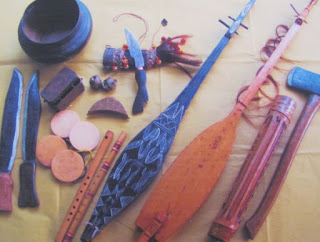This is the fifth part of the list of 10 tribes in Davao.
Obu Manuvu
 |
| Deputy Mayor Omelis Duyan |
The Obus occupy Tambolong, Baguio District, and Marilog District on the Davao side, and Arakan, Antipas, Roxas, MAgpet, Kidapawan, Makilala on the Cotabato side. Stray froups can be found in Southern Cotabato.
As the Obus lived in very remote areas, the Spaniards failed to identify them as a separate tribe and simply lumped them together with the Atas. Pastellas called Atas "the indigenous natives who generally lived about the western districts of Mt. Apo."
An Obu epic tells of the adventures of Tuwaang, particularly his fight with the Moros. Tuwaang is actually claimed by many other tribes, as variants of the Tuwaang epic are also sang among the Ata Manobo tribe in Talaingod in Davao del Norte and the Matigsalogs in San Fernando, Bukidnon. But instead of Tuwaang, the name of their hero is Tulalang. A common theme of his adventures is his fight with the Ikogans (tailed men) who are associated with the Moros.
Obu oral tradition tells of Apo Sandawa's journey from the north to Davao. Apo Sandawa's point of entry in Davao was at Ulas. If so, this suggests a sea journey. From Ulas, Apo Sandawa and hid family moved north towards the Talomo mountains, even reaching Mt. Sinaka. Apo Sandawa's journey ended in Mt. Apo where he was buried. Apo Sandawa is considered the ancestor of the Obus.
Based on oral tradition, we can say that the Obus would most likely come from Butuan area. They would most likely be related to the Manobos of Agusan. Indeed, Obus can be classified linguistically under the Manobo. Oral tradition and linguistic similarity tend to make the Obus, Kulaman Manobos, the Bagobos (Tagabawas), as well as the Dibabawons closely related peoples who belong to the bigger Manobo family.
The Obus can be found in the districts of Marilog, Baguio, Calinan and Tugbok.













































